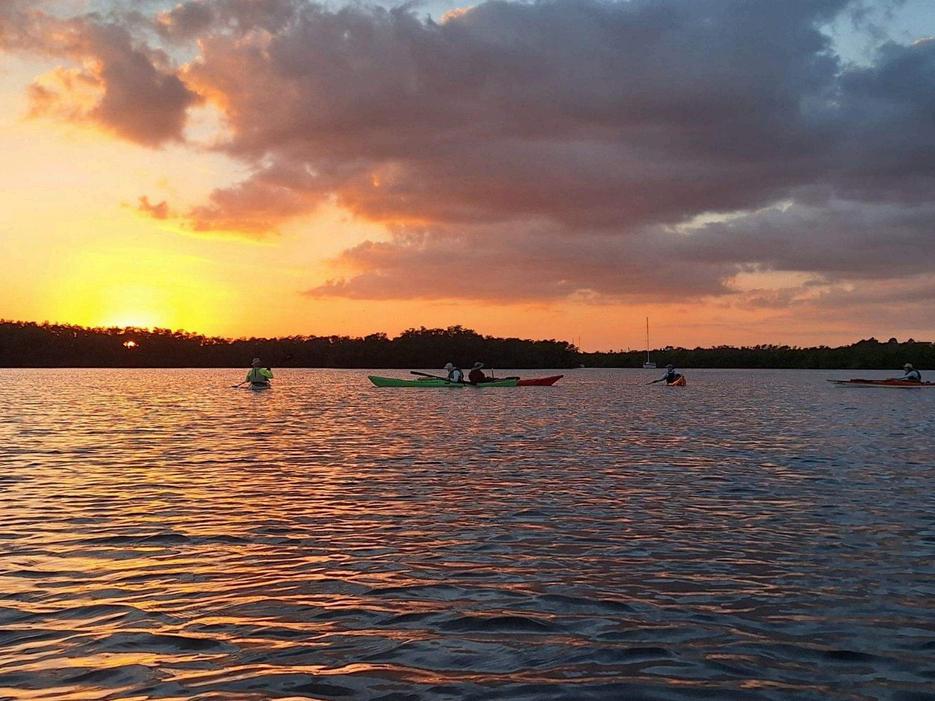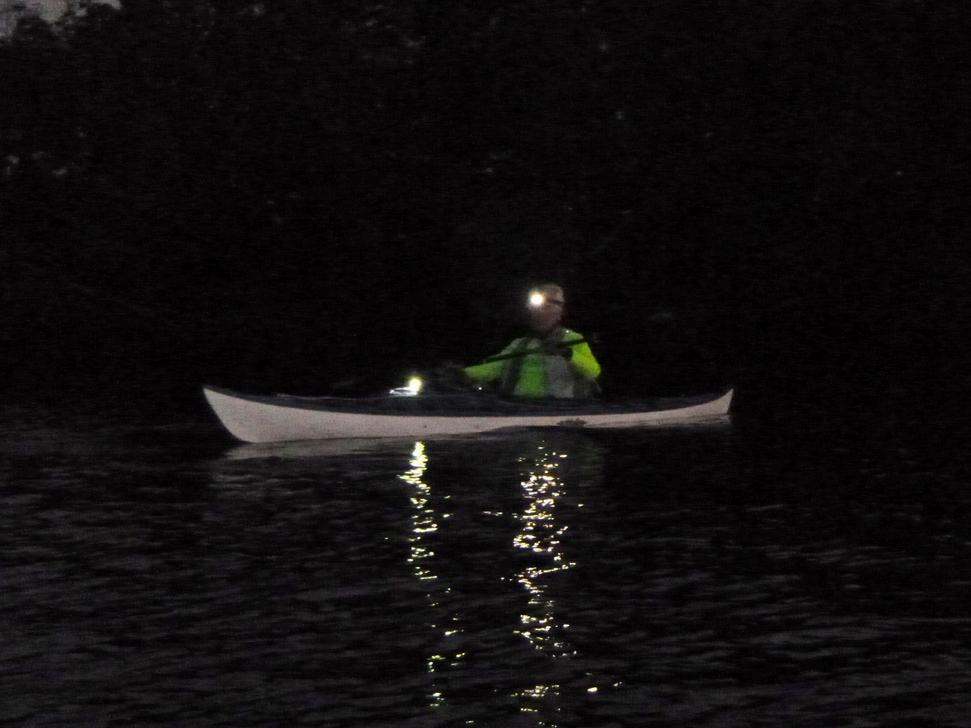
7 minute read
PADDLE SMARTS
by theensign
Night paddling
BY JIM GREENHALGH
Night paddling can be fun, but it’s important to be prepared when paddling in darkness.
Many paddlers enjoy the beauty and peace of moonlight paddling. Others paddle after dark to view bioluminescence, the night sky or city skyline; go fishing; or participate in night-lit boat parades. Whatever the reason, paddlecraft can be operated at night and during times of restricted visibility, but it requires extra planning, equipment and compliance with additional Navigation Rules.
When paddling during the day, all paddlers must carry a US Coast Guard-approved life jacket and a sound device such as a whistle. When paddling after dark, paddlers must add navigation lights and carry visual distress night signals when operating in coastal waters. Paddlers should always carry required night equipment on board, as everyone can expect occasional delays due to bad weather, mechanical breakdown or other unexpected circumstances that may require returning after dark.
Navigation lights for paddlecraft
Paddlecraft must exhibit navigation lights from sunset to sunrise as per Navigation Rule 20, and no other lights should be displayed that could be mistaken for navigation lights. Paddlecraft have three options for navigation lights, which are described in Rule 25.


Paddlecraft may display the typical running lights of a sailboat (red and green sidelights and a white sternlight) as described in Rule 25, or they may simply carry a white flashlight that can be exhibited in time to prevent a collision per Rule 25(d)(ii). The U.S. Inland Rules also allow a white all-round light to be shown. It should be noted that this all-round light is not recognized as an option under the International Rules (offshore outside the COLREGS demarcation line).
Paddlecraft operators should carefully choose the navigation lights they use aboard their vessel. Paddlers can mount regular running lights as per Rule 25, and portable battery-powered running lights are available on the market. These running lights must comply with the technical requirements defined in Rule 21 and the provisions of Annex I of the Navigation Rules. My experience has shown that some lights on the market do not meet the technical requirements, and few paddlers mount regular running lights properly. Technical issues such as these could become a significant issue in the event of a collision.
Paddlers can mount the white all-round light on their vessel, but it must show “an unbroken light over an arc of the horizon of 360 degrees” per Rule 21(c). Some lights on the market are too short to meet this requirement as the light will be blocked by the paddler, so the light must be mounted so that it is above the head of the paddler. Also, this light is not recognized as a legal navigation light in the International Rules, so paddlers operating at night in offshore waters, outside the COLREGS demarcation line, should use the regular red, green and white running lights or just carry a white flashlight.
The easiest way for paddlecraft operators to comply with both the International and Inland Rules is to simply carry a white flashlight that can be exhibited in time to prevent a collision. Paddlers should consider carrying a flashlight with them at all times in case circumstances arise that require paddling after dark. Also, consider that white light will temporarily blind anyone viewing it close by. Paddlers navigating at night to sightsee will appreciate not having a white light shining in their eyes. When leading a group at night I always request paddlers using regular running lights (which requires a white light on the stern) and those using the all-round white light to stay in the rear so as not to blind the other paddlers in the group.
Visual distress signals
Paddlers operating at night must carry visual distress signals approved for night use when paddling on US coastal waters, including in bays, inlets and rivers, where the waterway is more than 2 miles wide (33 CFR 175101).
Two types of night-use visual distress signals are available to boaters.
Pyrotechnics, which include handheld flares and red aerial meteor or parachute flares, carry a printed expiration date. A minimum of three up-to-date devices must be carried aboard to meet the visual distress signal requirement. Expired devices may be carried as extra equipment. The most useful pyrotechnic devices for paddlers are the red aerial meteor flares that can be launched up to around 500 feet by either a rip cord-type device or a 12-gauge flare launcher. Pyrotechnics can be dangerous if not used properly, so the user should read the directions and use caution.
Electronic visual distress signals: Paddlers not wanting to carry pyrotechnics or be concerned about expiration dates can opt for a USCG-approved electronic visual distress signal. These are battery-operated strobe light devices, handheld or designed to float, that flash the S-O-S light sequence.


Recommended additional safety equipment
All paddlers should carry a marine VHF radio. This is more important at night in case a paddler needs to contact another vessel to make it aware of their presence or in case of emergency. A handheld charting GPS is helpful to navigate and monitor one’s current position on a bright map screen during darkness. Paddlers should also consider carrying an air horn at the ready, which is more likely than a whistle to gain the attention of another boater who may not be aware of the presence of paddlecraft. Wearing reflective clothing and having SOLAS (Safety of Life at Sea) reflective tape on the PFD, boat and paddle can make a paddler more visible at night. Additionally, consider carrying a backup flashlight and extra batteries for lights or electronics.
Paddlers planning a night trip, or possibly a moonlight paddle, can find information regarding sunrise/sunset, moonrise/moonset and twilight times at Astronomical Tables.
Safe nighttime paddling can be enjoyable for all. Paddling at night can be fun and safe when paddlers have the knowledge and proper equipment to deal with nighttime conditions. Paddlers must always keep a sharp lookout, with both eyes and ears, for other vessel traffic while navigating in darkness. They should also make sure they can be seen and heard by displaying proper navigation lights and using a sound device such as an air horn.
Proper planning and carrying needed safety equipment for any scenario can make night paddling a safe and enjoyable experience.
ABOUT THE AUTHOR
Jim Greenhalgh of St. Petersburg Sail & Power Squadron/22 is a senior navigator, vessel examiner, and instructor, having taught boating safety and navigation since 1991 He draws on his vast sail and powerboating experience as a lifelong boater and avid sea kayaker Jim leads trips for the Kayak Adventure Group, a sea kayaking club based on Florida’s west coast that he co-founded. He also wrote Navigation Rules for Paddlecraft, a must-read for all paddlers.








